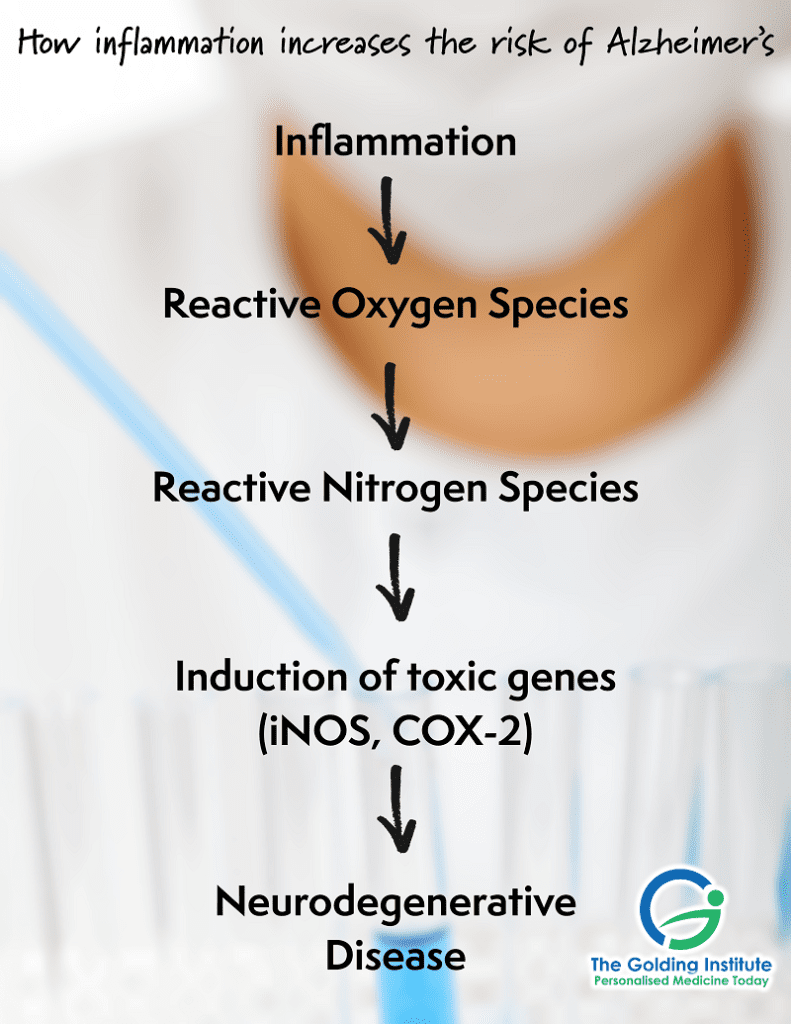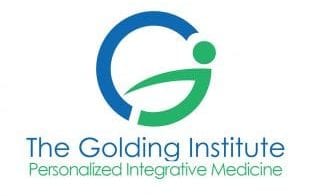
Alzheimer’s disease and dementia prevalence increase with age and the total number of people affected is expected to rise as time passes. The main reasons that the brain is affected by aging are largely attributable to:
- Inflammation
- Free radical damage to neurons and mitochondria
Inflammation and Alzheimer’s
The higher the inflammatory markers, the higher the incidence of Alzheimer’s disease and dementia. These inflammatory markers can be measured in the blood. There are several inflammation markers that can be tested, for example:
- Alpha1-antichymotrypsin
- II-6
- C-reactive protein
Why is this important to know?
Conditions that can be Triggered by Inflammation
- Proinflammatory cytokines which are immune system mediators
- Reactive microglia
- Activation of complement pathway, in essence, an immune system activation
This can be protected by anti-inflammatory drugs.
Reactive microglia express complement receptors. Complement activation, in turn, leads to beta-amyloid deposition. This is the hallmark of Alzheimer’s disease and dementia. Anti-inflammatories and aspirin have been proven to reduce the incidence of Alzheimer’s and dementia.

How to employ an integrative medicine approach to the treatment of Alzheimer’s Disease
Know that there is a broad definition of integrative and functional medicine.
In integrative medicine, one does not look at a person as a set of symptoms. In fact, the complexity of the human being sometimes overwhelms practitioners completely! We do, however, take biochemical individuality in account when approaching any patient.
Each person is acknowledged as an individual. The patient-centred approach allows for individualised Alzheimer’s or dementia treatment programs to be developed.
Health is not seen as the absence of disease. After all, we want optimal life!
This includes the use of supplementation and lifestyle management to reduce inflammation. It covers the expression of negative genes and variants as well.
Consider the Different Factors that Contribute to Alzheimer’s Disease
Alzheimer’s disease is not caused by a single factor. There are many contributors to the disease. Some of these include:
- Genetic predisposition
- Environmental toxicity
- Mitochondrial dysfunction
- Heavy metal toxicity
- Glutathione
The list above is by no means exhaustive. We cover this and more in the Cognitive Decline Course.
Consider the Genetic Influences on Alzheimer’s Disease and Dementia
There are specialized structures that cap the ends of eukaryotic chromosomes that are made up of DNA and protein. They are known as telomeres. Telomeres shorten with repeated cell division in somatic cells.
Once these telomeres reach a point where they cannot support normal division of chromosomes, abnormal chromosomal function can occur. This can result in the emergence of chronic disease such as Alzheimer’s disease and dementia.

There are several genes that can increase the risk of Alzheimer’s disease and dementia. We look mainly at what is called a set of single-nucleotide polymorphism, or SNP for short.
SNPs in the gene(s) involved in complex disease susceptibility can affect gene expression in several ways. A subset of SNPs in the coding sequence of a gene will alter biochemical activities of enzymes, proteins, and cellular processes.
Most polymorphisms arose many generations ago and spread slowly among different populations throughout human history. The persisting polymorphisms were selective neutral or conferred a certain advantage under the given circumstances.
Under altered circumstances, previously advantageous polymorphisms could now confer negative effects
One of the most important low penetrance genes that one should consider checking is the Apo-E allele.
Apo E4 individuals have on average a 10% higher total cholesterol level and 40% higher risk for coronary heart disease. They also have double the risk for Alzheimer’s disease.
It is associated with poor recovery from brain insults such as brain injury and cerebrovascular accidents – ischemic and hemorrhagic.
Consider Environmental Toxicity
There are many toxicity challenges to look out for with Alzheimer’s and dementia. One of the most overlooked ones is mold.

“Exposure to high levels of indoor mould can cause injury to and dysfunction of multiple organs and systems, including respiratory, haematological, immunological, and neurological systems, in immunocompetent humans.”
— Curtis L, Lieberman A, Stark M. Adverse Health Effects of Indoor Molds. Journal of Nutritional & Environmental Medicine. 2004;14(3):261-274. doi:10.1080/13590840400010318.
Consider Mitochondrial Function

These little critters are of paramount importance with all disease states. Having enough energy to repair the body is something that cannot be stressed enough. We recently had a discussion on how to optimize mitochondrial function for Alzheimer’s disease. The podcast is listed below:
Consider the Effects of Heavy Metals
Aluminium is a very abundant metal found in food, soil, water and even the air we breathe. It can also be found in antacids, deodorants, cookware, processed cheeses. Alzheimer’s sufferers tend to have very high levels of aluminium (up to 30 times the normal levels in the brain).
Glutathione and Alzheimer’s
Glutathione is a tripeptide that is made up out of cysteine, glutamine and glycine. It protects us from reactive oxygen species as well as from reactive nitrogen species.
Glutathione is a cofactor for many antioxidant enzymes such as peroxidases and transferases and the storage form of cysteine. It is also a storage form and transporter of nitric oxide.
Importantly, it metabolizes estrogens, leukotrienes, and prostaglandins. It is also involved in the regulation of some transcription factors. It detoxifies many endogenous substances and xenobiotics, mycotoxins and other toxins.
Don’t Get Overwhelmed with Alzheimer’s Disease
From the above, it is easy to see why so many practitioners find the treatment of Alzheimer’s disease and dementia challenging. And this is only the tip of the iceberg.
The good news is that practitioners such as Dr Dale Bredesen has done a lot of work and put together protocols which are of immense help.
Here at the Golding Institute, we have put together our own training program and protocols. They include what we have seen helps our patients with Alzheimer’s and dementia.
Do not hesitate to get in touch with us to find out more. If you feel uncomfortable, refer patients to us.
